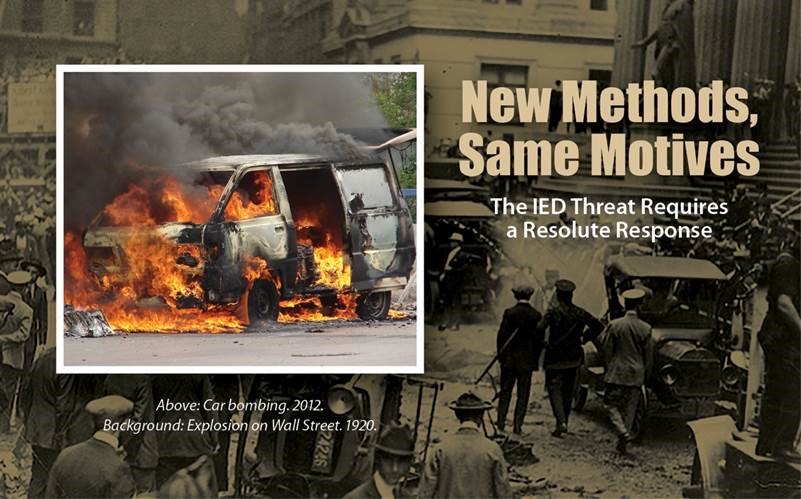
THE EVOLVING THREAT
The defeat of improvised explosive devices (IEDs) is, and has always been, a complex and constantly changing problem set. While the designs and methods used to build and deploy bombs have evolved, the desire of individuals and organizations to cause harm using IEDs has been constant, and unfortunately has a long history.

Going back 400 years, the Gunpowder Plot to blow up the King, Queen, and Houses of Parliament in England in 1605 saw Guy Fawkes arrested with 36 kegs of gunpowder and a box of matches. 300 years later, in September 1920, a bomb pulled to a busy section of Wall Street in New York City by a horse-drawn cart detonated, killing more than 30 people and injuring 300. In the late 20th century, our nation suffered acts of domestic terrorism, such as the Unabomber bombings from 1978-1995 and the 1995 Oklahoma City bombing, as well as the 1993 World Trade Center bombing perpetrated by an international terrorist organization.
In recent years, increased difficulty for ‘bad actors’ in obtaining commercial and military grade explosives led to a shift in focus toward homemade explosives (HME) – many of which can be easily constructed with over-the-counter materials. The internet has facilitated purchase of these materials and enabled access to the knowledge required to make HMEs and IEDs. There are numerous documented cases of grave injuries and even death to people handling (and mishandling) explosives and specifically HMEs. Even so, individuals are still creating and deploying IEDs prepared from HMEs in myriad ways:
- In 2013 a St. Clements, Manitoba man delivered three mail bombs and detonated a fourth device made with triacetone triperoxide (TATP);
- In 2017, a Bedminster, UK man plead guilty to five charges after a bomb squad identified 251 IEDs along with home-made black powder, flash powder, and erythritol tetranitrate (ETN) at his residence;
- In 2017, a 14-year old boy in Provo, UT was arrested for possession of an explosive device and for an explosion causing property damage. Numerous chemicals used to manufacture hexamethylene triperoxide diamine (HMTD), ETN, and black powder were found at his home;
- In 2018, a Milford Township, PA man was arrested after police identified four explosive devices and ETN in his home and more explosive devices at his place of business; and
- In June 2020 in Ben Lemond, CA, a suspect attacked police with multiple IEDs. Many more IEDs were found in the suspects home later the same day.
- The above represent a small fraction of recent IED events where arrests* were made and do not include the numerous actions by known international terrorist organizations.
STAYING VIGILANT
Even as America’s military engagements in Iraq and Afghanistan wind down, the threat of individuals and organizations, both foreign and domestic, employing IEDs remains. The challenge to defeat these threats is largely borne by our military and law enforcement as part of broader counterterrorism or law enforcement efforts that focus on the activities of individuals or organizations (networks). Industry partners such as Signature Science can support their efforts by offering, from science and technology perspectives, valuable understanding of the IED-related activities of these adversaries.
Signature Science will soon enter its third decade of supporting our nation’s ongoing efforts to counter CBRNE and IED threats. We’ve taken a multidisciplinary approach to recognizing the signatures of homemade explosives manufacturing and IED fabrication activities and supporting bomb maker identification with forensic analysis of evidence. Chemistry staff are experts in explosives synthesis, testing, collection, and detection; perform explosives signature detection and characterization research; develop and produce explosives detection K9 training aids; and provide HME subject matter expertise to DoD, DHS, and law enforcement. Signature Science’s forensic and genomics scientists, supported by our ANAB-accredited DNA casework laboratory, are focused on developing tools and methods for extracting human identification evidence from the most challenging samples.
Further, we transfer our sophisticated understanding of emerging HME threats to the delivery of safe, realistic training exercises to law enforcement officers, soldiers, and first responders. Signature Science’s HME courses teach students to recognize the hallmarks and indicators of HME production.
As the IED threat continues to evolve, Signature Science remains steadfast in our resolve to engage our science and technology expertise in support of our nation’s front-line responders.
For more information on Signature Science’s offerings:

Michael Re, PhD
Director, CBRNE Sciences
Dr. Michael Re currently serves as the Director and a Principal Scientist for the CBRNE Sciences Business Area at Signature Science, where he provides management oversight and expert advice in support of programs related to national defense and homeland security. Dr. Re has over 30 years of experience in organic and analytical chemistry, quality assurance, management, regulatory compliance, and health and safety.
*According to federal laws, it is unlawful to make, handle, store, transport or use explosives without a proper license from The Bureau of Alcohol, Tobacco, Firearms and Explosives.

